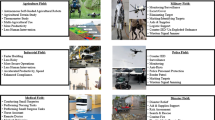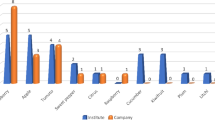Abstract
Interconnected devices and mobile multi-robot systems are increasingly present in many real-life scenarios. To be effective, these systems need to collect large amounts of data from their environment, and often these data need to be aggregated, shared, and distributed. Many multi-robot systems are designed to share state information and commands, but their communication infrastructure is often too limited for significant data transfers. This paper introduces Swarm-Oriented Upload of Labeled data, a mechanism that allows members of a fully distributed system to share data with their peers. We leverage a BitTorrent-like strategy to share data in smaller chunks, or datagrams, with policies that minimize reconstruction time. We performed extensive simulations to study the properties of the system and to demonstrate its scalability. We report experiments conducted with real robots following two realistic deployment scenarios: searching for objects in a scene, and replacing the full identity of a defective robot.











Similar content being viewed by others
References
Barabási, A. L., & Albert, R. (1999). Emergence of scaling in random networks. Science, 286(5439), 509–512.
Barange, M. Y, & Sapkal, A. K. (2016). Review paper on implementation of multipath reactive routing protocol in manet. In IEEE international conference on electrical, electronics, and optimization techniques (ICEEOT) (pp. 227–231).
Bayindir, L. (2016). A review of swarm robotics tasks. Neurocomputing, 172, 292–321. https://doi.org/10.1016/j.neucom.2015.05.116.
Benet, J. (2014). Ipfs-content addressed, versioned, p2p file system. arXiv preprint arXiv:1407.3561.
Best, G., Forrai, M., Mettu, R.R., & Fitch, R. (2018). Planning-aware communication for decentralised multi-robot coordination. In Proceedings of the international conference on robotics and automation, Brisbane, Australia (vol. 21).
Brown, S., & Sreenan, C. (2013). Software updating in wireless sensor networks: A survey and Lacunae (vol. 2). https://doi.org/10.3390/990jsan2040717.
Brunet, L., Choi, H.L., & How, J.P. (2008). Consensus-based auction approaches for decentralized task assignment. In AIAA guidance, navigation, and control conference, August (pp. 1–24).
Chissungo, E., Blake, E., & Le, H. (2011). Investigation into batman-adv protocol performance in an indoor mesh potato testbed. In 2011 Third international conference on intelligent networking and collaborative systems, IEEE (pp. 8–13).
Davis, D. T., Chung, T. H., Clement, M. R., & Day, M. A. (2016). Consensus-based data sharing for large-scale aerial swarm coordination in lossy communications environments. In IEEE/RSJ international conference on intelligent robots and systems (IROS) (pp. 3801–3808) https://doi.org/10.1109/IROS.2016.7759559.
Dhurandher, S. K., Singhal, S., Aggarwal, S., Pruthi, P., Misra, S., & Woungang, I. (2009). A swarm intelligence-based P2P file sharing protocol using Bee Algorithm. In 2009 IEEE/ACS international conference on computer systems and applications, AICCSA 2009 (pp. 690–696). https://doi.org/10.1109/AICCSA.2009.5069402.
Dias, M. B., Zlot, R., Kalra, N., & Stentz, A. (2006). Market-based multirobot coordination: A survey and analysis. Proceedings of the IEEE, 94(7), 1257–1270.
Faludi, R. (2010). Building wireless sensor networks: With ZigBee, XBee, arduino, and processing. Newton: O’Reilly Media Inc.
Ganesan, P., Gummadi, K., & Garcia-Molina, H. (2004). Canon in g major: designing DHTS with hierarchical structure. In Proceedings of the 24th international conference on distributed computing systems 2004 (pp. 263–272).
Garbacki, P., Iosup, A., Epema, D., & van Steen, M. (2006). 2Fast : Collaborative downloads in P2P networks. Sixth IEEE international conference on peer-to-peer computing (P2P’06) (pp. 23–30). https://doi.org/10.1109/P2P.2006.1.
Ghedini, C., Ribeiro, C. H. C., & Sabattini, L. (2016). Improving the fault tolerance of multi-robot networks through a combined control law strategy. In 2016 8th international workshop on resilient networks design and modeling (RNDM) (pp. 209–215). https://doi.org/10.1109/RNDM.2016.7608289.
Howard, A., Matarić, M., & Sukhatme, G. (2002). Mobile sensor network deployment using potential fields: A distributed, scalable solution to the area coverage problem. In Proceedings of the international symposium on distributed autonomous robotic systems (DARS) (pp. 299–308). Springer, New York.
Kamra, A., Misra, V., Feldman, J., & Rubenstein, D. (2006). Growth codes: Maximizing sensor network data persistence. ACM SIGCOMM Computer Communication Review, ACM, 36, 255–266.
Kelley, D. H., & Ouellette, N. T. (2013). Emergent dynamics of laboratory insect swarms. Scientific Reports, 3, 1073.
Kuriki, Y., & Namerikawa, T. (2015). Experimental validation of cooperative formation control with collision avoidance for a multi-UAV system. In: Proceedings of the 6th international conference on automation, robotics and applications (pp. 531–536).
Laukkanen, E., Itkonen, J., & Lassenius, C. (2017). Problems, causes and solutions when adopting continuous delivery: A systematic literature review. Information and Software Technology, 82, 55–79. https://doi.org/10.1016/j.infsof.2016.10.001.
Lee, D. H. (2018). Resource-based task allocation for multi-robot systems. Robotics and Autonomous Systems, 103, 151–161.
Lliffe, M. (2016). Drones in humanitarian action. Technical report, The Swiss Foundation for Mine Action, Geneva/Brussels, http://drones.fsd.ch/.
McDonald, S. J., Colton, M. B., Alder, C. K., & Goodrich, M. A. (2017). Haptic shape-based management of robot teams in cordon and patrol. In Proceedings of the 2017 ACM/IEEE international conference on human-robot interaction-HRI ’17 (pp. 380–388). https://doi.org/10.1145/2909824.3020243.
Otte, M., Kuhlman, M., & Sofge, D. (2017). Multi-robot task allocation with auctions in harsh communication environments. In IEEE 2017 international symposium on multi-robot and multi-agent systems (MRS) (pp. 32–39).
Pinciroli, C., & Beltrame, G. (2016a). Buzz: An extensible programming language for heterogeneous swarm robotics. In International conference on intelligent robots and systems (pp. 3794–3800). IEEE.
Pinciroli, C., & Beltrame, G. (2016b). Swarm-Oriented programming of distributed robot networks. Computer, 49(12), 32–41. https://doi.org/10.1109/MC.2016.376.
Pinciroli, C., Trianni, V., O’Grady, R., Pini, G., Brutschy, A., Brambilla, M., et al. (2012). ARGoS: A modular, parallel, multi-engine simulator for multi-robot systems. Swarm Intelligence, 6(4), 271–295. https://doi.org/10.1007/s11721-012-0072-5.
Pinciroli, C., Lee-Brown, A., & Beltrame, G. (2016). A tuple space for data sharing in robot swarms. In Proceedings of the 9th EAI international conference on bio-inspired information and communications technologies (formerly BIONETICS) (pp. 287–294). https://doi.org/10.4108/eai.3-12-2015.2262503.
Redmon, J., Divvala, S., Girshick, R., & Farhadi, A. (2016). You only look once: Unified, real-time object detection. In Proceedings of the IEEE conference on computer vision and pattern recognition (pp. 779–788).
Reid, N. (2015). Literature review: Purely decentralized P2P file sharing systems and usability. Technical reports, Rhodes University, Grahamstown.
Ren, W., Beard, R., & Atkins, E. (2005). A survey of consensus problems in multi-agent coordination. In Proceedings of the American control conference (pp. 1859–1864). https://doi.org/10.1109/ACC.2005.1470239.
Sandholm, T., Sandholm, T., Suri, S., & Suri, S. (2000). Improved algorithms for optimal winner determination in combinatorial auctions and generalizations. In Proceedings of the national conference on artificial intelligence (AAAI) (pp. 90–97).
Sen, S. D., & Adams, J. A. (2013). A decision network based framework for multiagent coalition formation. In Proceedings of the 2013 international conference on autonomous agents and multi-agent systems (pp. 55–62).
Shahriari, M., Svogor, I., St-Onge, D., & Beltrame, G. (2018). Lightweight collision avoidance for resource-constrained robots. In 2018 IEEE/RSJ international conference on intelligent robots and systems (IROS). IEEE.
Soares, J. M., Navarro, I., & Martinoli, A. (2016). The khepera iv mobile robot: Performance evaluation, sensory data and software toolbox. In Robot 2015: Second Iberian robotics conference (pp. 767–781). Springer.
St-Onge, D., Varadharajan, V. S., Li, G., Svogor, I., & Beltrame, G. (2018). Ros and buzz: Consensus-based behaviors for heterogeneous teams. In International conference on intelligent robots and systems. IEEE. https://arxiv.org/abs/1710.08843.
Støy, K. (2001). Using situated communication in distributed autonomous mobile robots. In Proceedings of the 7th Scandinavian conference on artificial intelligence (pp. 44–52).
Surmann, H., Berninger, N., & Worst, R. (2017). 3D mapping for multi hybrid robot cooperation. In IEEE international conference on intelligent robots and systems 2017-Sept (pp. 626–633). https://doi.org/10.1109/IROS.2017.8202217.
Varadharajan, V., St-Onge, D., Guss, C., & Beltrame, G. (2018). Over-the-air updates for robotic swarms. In IEEE software.
Vempati, A. S., Gilitschenski, I., Nieto, J., Beardsley, P., & Siegwart, R. (2017). Onboard real-time dense reconstruction of large-scale environments for UAV. In IEEE international conference on intelligent robots and systems 2017-Septe (pp. 3479–3486). https://doi.org/10.1109/IROS.2017.8206189.
Vig, L., & Adams, J. A. (2006). Market-based multi-robot multi-robot coalition formation. Distributed Autonomous Robotic Systems (Vol. 7, pp. 227–236). Tokyo: Springer.
Vu, Q. H., Lupu, M., & Ooi, B. C. (2010). Architecture of peer-to-peer systems. In Peer-to-peer Computing (pp. 11–37). Springer.
Wei, X., Fengyang, D., Qingjie, Z., Bing, Z., & Hongchang, S. (2015). A new fast consensus algorithm applied in rendezvous of. In 2015 27th Chinese control and decision conference (CCDC) (pp. 55–60). https://doi.org/10.1109/CCDC.2015.7161666.
Zhang, K., Collins, E. G., Shi, D., Liu, X., & Chuy, O. (2009). A stochastic clustering auction (SCA) for centralized and distributed task allocation in multi-agent teams. Distributed Autonomous Robotic Systems 8, 7(2), 345–354. https://doi.org/10.1007/978-3-642-00644-9-31.
Acknowledgements
We would like to thank NSERC for supporting this work under the NSERC Strategic Partnership Grant (479149). Simulation experiments were performed on the Mammouth-Ms supercomputer of the Université de Sherbrooke, managed by Calcul Québec and Compute Canada. We thank Calcul Québec and Compute Canada for making the resource available.
Author information
Authors and Affiliations
Corresponding author
Additional information
Publisher's Note
Springer Nature remains neutral with regard to jurisdictional claims in published maps and institutional affiliations.
This is one of the several papers published in Autonomous Robots comprising the Special Issue on Multi-Robot and Multi-Agent Systems.
Electronic supplementary material
Below is the link to the electronic supplementary material.

Supplementary material 2 (mp4 31804 KB)
Rights and permissions
About this article
Cite this article
Varadharajan, V.S., St-Onge, D., Adams, B. et al. SOUL: data sharing for robot swarms. Auton Robot 44, 377–394 (2020). https://doi.org/10.1007/s10514-019-09855-2
Received:
Accepted:
Published:
Issue Date:
DOI: https://doi.org/10.1007/s10514-019-09855-2




